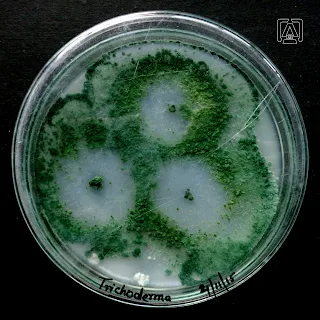Biological control
Biological control, sometimes
abbreviated as ‘biocontrol’ is the suppression of the population of plant pathogens
by living organisms. The organism that suppresses the plant pathogen is called as a biocontrol agent. The term also covers the application of natural products extracted or fermented through the biological organism to control plant
diseases. The biocontrol agents are generally bacteria or fungi isolated from
the endosphere, rhizosphere or phyllosphere. Actinomycetes, Mycoviruses and
bacteriophage are well used as biocontrol agents. Biocontrol agents are usually
mixed in soil for application. They prevent the infection of pathogens or kill
them in a very specific manner, thus causing no harm to the host plants.
Some common biocontrol agents tested against various plant pathogens are listed here:
Some common biocontrol agents tested against various plant pathogens are listed here:
 |
| Trichoderma PC: Dr. Ifra Zoomi |
- Bacillus subtilis against Phytophthora capsici (blight of Pepper).
- Bacillus subtilis against Pseudocercospora musae (yellow sigatoka of Banana).
- Flavobacterium against Phytophthora cactorum (rots in Apple).
- Gliocladium catenulatum against Plasmodiophora brassicae (clubroot disease of Chinese Cabbage).
- Mixture of Trichoderma harzianum + Trichoderma virideae (with Arbuscular Mycorrhiza) against Puccinia graminis f. sp. tritici (stem rust of wheat).
- Paecilomyces against Phytophthora cactorum (rots in Apple).
- Phage PhiRSL1 against Ralstonia solanacearum (bacterial wilt of Tomato).
- Trichoderma atroviridae against Botrytis cinerea (grey mold of Strawberry).
- Trichoderma harzianum against Phytophthora cactorum (rots in Apple).
Commercially available biocontrol agents
- Ampelomyces quisqualis M-10 against Powdery mildews by EcoGen in USA.
- Bacillus subtilis MB1600 against fungal pathogens of cotton, legumes and soybeans by Beker Underwood in USA.
- Coniothyrium minitan against root rot diseases by Prophyta Biologischer in Germany and by Bioved in Hungary.
- Fusarium oxysporum non-pathogenic against wilt diseases by S.I.A.P.A. in Italy and by Natural Plant Protection in France.
- Gliocladium catenulatum against Root rot wilt by Verdera in Finland.
- Pseudomonas fluorescens and Pseudomonas syringae against certain fruits, almond, potato, tomato by Frost Technol Corp in Canada.
- Pythium oligandrum against root rot by Bioreparaty in Czech Republic.
- Streptomycine griseoviridis against soil-born pathogens of tree seedlings and ornamentals by Kemira Oy in Finland.
- Trichoderma harzianum against grey mold by Makhteshim Chemical Works in Israel.
- Trichoderma spp. against root rot wilt by Binab in Sweden, by Bioplant in Denmark and by Agrimm Technologies in New Zealand.
- Trichoderma viride against root rot wilt by Ecosense Laboratories in India.
- Xanthomonas campestris phage and Pseudomonas syrinage phage against bacterial pathogens of fruits and vegetables by Omnilytics in USA.
Advantages
- Biocontrol agents are easy to manufacture.
- They are cheaper than chemical methods.
- They are highly specific and active against a particular pathogen, hence do not cause harm to the host.
- Use of biocontrol agents is safe to the environment.
- Biocontrol agents also function as biofertilizers as they improve nutrient uptake, e.g., Trichoderma sp. is a good phosphate solubilizer.
- Biocontrol agents are easy to apply and cause no harm to the person who applies.
Disadvantages
- Biocontrol method is a preventive measure, it can not cure an established plant disease.
- They are very specific to a particular pathogen.
- They are usually less effective than chemical control methods.
- Very few biocontrol agents are available and only for a few diseases in limited regions of the world.
- They are not available in larger quantities.
- Shelf life of biocontrol agents is short, e.g., Trichoderma is viable only for up to four months.
References
- O’Brien, P.A. Biological control of plant diseases. Australasian Plant Pathol. 46, 293–304 (2017). https://doi.org/10.1007/s13313-017-0481-4
- Junaid, J.M., Dar, N.A., Bhat, T.A., Bhat, A.H. and Bhat, M.A., 2013. Commercial biocontrol agents and their mechanism of action in the management of plant pathogens. International Journal of Modern Plant & Animal Sciences, 1(2), pp.39-57.
Content first created on 07-05-2020
last updated on 30-11-2022
last updated on 30-11-2022

